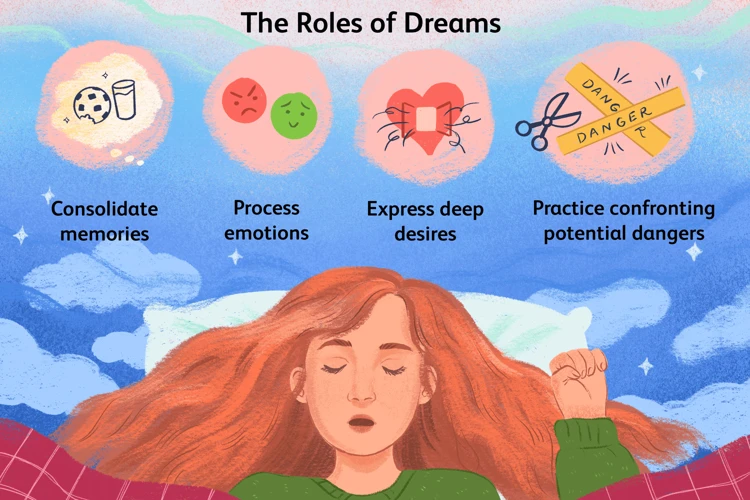Recurring dreams can be a perplexing phenomenon that many people experience. These dreams are characterized by the same themes, situations, or emotions occurring repeatedly throughout different nights. Understanding the underlying reasons behind recurring dreams and finding ways to stop them can provide a sense of relief and peace during sleep. In this article, we will explore the nature of recurring dreams, why they happen, and provide step-by-step tips on how to break the cycle and put an end to these recurring dreams once and for all. So, if you are tired of being stuck in a repetitive dream loop, read on to discover effective strategies that will help you gain control over your dreams and enjoy a more restful sleep.
Understanding Recurring Dreams

Recurring dreams are a fascinating aspect of the human subconscious mind that often leaves individuals pondering their meaning and significance. These dreams, which are characterized by persistent patterns or themes that recur over time, can vary widely from person to person. Some individuals may experience recurring dreams that are filled with fear and anxiety, while others may encounter recurring dreams tied to certain locations or events in their lives. Despite the differences in content, recurring dreams share a common thread of repetition that can leave individuals feeling unsettled and eager to unravel their hidden messages. By delving into the depths of their symbolism and exploring the underlying emotions they evoke, one can begin to unlock the mysteries behind recurring dreams and gain insights into their own psyche. So, whether you are curious about the impact of recurring nightmares on your overall well-being or interested in exploring the common themes in recurring dreams, this section will provide you with a deeper understanding of the fascinating world of recurring dreams.
What are recurring dreams?
Recurring dreams refer to a type of dream that occurs repeatedly over a period of time, featuring similar themes, situations, or emotions on different occasions. These dreams may manifest in various forms, such as recurring nightmares filled with fear and anxiety or dreams centered around familiar people or places. They can occur sporadically throughout a person’s life or for a concentrated period. Recurring dreams often captivate individuals, compelling them to analyze the meaning behind these repetitive experiences. While the specific content and symbolism may differ from person to person, the common thread in recurring dreams is the repetition, which suggests that there is something significant that the dreamer needs to pay attention to. By exploring the themes and emotions within these dreams, individuals can gain valuable insights into their subconscious mind and potentially uncover unresolved issues or unresolved emotions in their waking life. To delve deeper into the impact of recurring dreams on sleep and well-being, press here.
Why do we have recurring dreams?
Recurring dreams have long intrigued and puzzled dream researchers and psychologists alike. There are several theories as to why we experience recurring dreams, each offering a unique perspective on this intriguing phenomenon. One theory suggests that recurring dreams may be the result of unresolved emotions or unresolved conflicts in our waking lives. These dreams act as a subconscious mechanism to remind us of the unresolved issues that need our attention and resolution. Another theory suggests that recurring dreams serve as a form of rehearsal or preparation for potential future events or challenges we may face. These dreams provide an opportunity for us to mentally and emotionally prepare ourselves for these situations. Additionally, some researchers propose that recurring dreams may be a manifestation of our brain’s attempt to integrate and consolidate new information or experiences into our long-term memory. This process involves replaying and reprocessing the same dream content repeatedly, aiding in the retention and understanding of information. While the exact reasons for recurring dreams may vary from person to person, it is evident that they serve a purpose in our psychological and emotional lives. Understanding and exploring the underlying reasons for recurring dreams can provide valuable insights into our subconscious mind and help us unravel the hidden meanings behind these repetitive nocturnal experiences. So, whether you are curious about the impact of recurring nightmares on your overall well-being or interested in exploring the common themes in recurring dreams, this article will delve further into the subject, offering you guidance and techniques to break the cycle and find resolution.
Signs Your Dream is Recurring

– Vivid Recollection: One of the first signs that your dream is recurring is the vividness of your recollection. You may find that even hours or days after waking up, the details of the dream remain fresh in your mind. This clarity and ability to remember specific elements of the dream are indicators that it is recurring in nature.
– Repetitive Themes or Situations: Recurring dreams often revolve around specific themes or situations that repeat themselves. For example, you may find yourself constantly dreaming about falling, being chased, or being unprepared for an important event. These repetitive themes can be a clear sign that you are experiencing recurring dreams.
– Emotional Intensity: Another characteristic of recurring dreams is the intensity of the emotions they evoke. You may find yourself feeling heightened levels of fear, anxiety, or stress during the dream, regardless of its content. This emotional intensity can linger even after waking up, further emphasizing the recurring nature of the dream.
– Familiarity and Deja Vu: Recurring dreams often have a sense of familiarity and deja vu associated with them. You may have a strong feeling that you have experienced the dream before, even if the specific details differ slightly. This sensation of familiarity is a strong indication that the dream is recurring.
– Sleep Disturbances: Recurring dreams can also disrupt your sleep. You may find yourself waking up frequently or experiencing restless sleep patterns as a result of these recurring dreams. These sleep disturbances can be a valuable clue in identifying that your dream is recurring and warrants further exploration.
By recognizing these signs, you can become more aware of the recurring nature of your dreams and begin to unravel their underlying meanings and messages. If you find that recurring dreams are causing distress or impacting your overall well-being, it may be helpful to seek professional guidance to further understand and address these dreams. You can learn more about the impact of recurring nightmares on mental health and strategies to cope with them by reading our article on recurring nightmares and fear. Additionally, exploring common themes in recurring dreams can provide valuable insights into their significance and help you navigate your own dream world. Take a look at our article on common themes in recurring dreams to delve deeper into understanding the patterns and symbolism within your own recurring dreams.
Identify the Underlying Issues

One of the key steps in stopping recurring dreams is to identify the underlying issues that may be triggering them. This process involves introspection and analysis of the subconscious mind. One effective technique is to keep a dream journal, where you can jot down the details of your dreams as soon as you wake up. Looking for patterns and symbols can provide valuable clues about the themes and emotions that recur in your dreams. By organizing this information in a table or a list, you can easily spot commonalities and gain a better understanding of the root causes behind your recurring dreams. Once you have identified the underlying issues, you can start working towards resolving them and breaking the cycle of these repetitive dreams. So, grab a pen and paper, and embark on the journey of self-discovery through your dreams.
Keep a dream journal
Keep a dream journal
Keeping a dream journal is a valuable practice when it comes to understanding and eventually stopping recurring dreams. By recording your dreams immediately upon waking, you can capture the details and emotions while they are still fresh in your mind. This can help you identify patterns, recurring themes, and symbols that may be present in your dreams. Start by keeping a notebook and pen next to your bed, or use a digital journaling app on your phone. As soon as you wake up, jot down all the details you remember, including people, places, objects, and any specific emotions or sensations you experienced. Be as descriptive as possible, but don’t worry about grammar or coherence. The goal is to create a log of your dreams that you can later analyze. Reviewing your dream entries regularly may reveal connections and themes that could shed light on the underlying issues causing your recurring dreams. Additionally, consider using a dream journal template or creating categories to track certain elements such as colors or recurring characters. This organization can help you identify any common threads within your dreams more easily. So, grab a journal and start unraveling the mysteries of your subconscious mind by keeping a dream journal.
Look for patterns and symbols
Look for patterns and symbols in your recurring dreams can provide valuable insights into their underlying meanings. Patterns can be observed by identifying recurring themes, situations, or images that appear consistently throughout your dreams. These patterns may represent certain aspects of your life or emotions that you need to address or understand. Pay attention to any recurring symbols in your dreams as well. Symbols can carry personal meanings and may act as metaphors for unconscious thoughts or feelings. For example, seeing a snake in your recurring dreams might symbolize hidden fears or anxieties. Keeping a dream journal can be immensely helpful in recognizing and documenting these patterns and symbols. Writing down the details of your dreams as soon as you wake up can help capture the nuances and vivid imagery while they are still fresh in your mind. Over time, analyzing patterns and symbols in your dreams can provide valuable clarity and guidance for breaking the cycle and interpreting the messages your subconscious mind is trying to convey.
Work on Emotional Healing

Emotional healing is a crucial step in breaking the cycle of recurring dreams. To begin this process, it is helpful to keep a dream journal to record the details of each dream. By doing so, you can identify patterns and symbols that may be linked to unresolved emotions or past traumas. Additionally, practicing mindfulness and meditation can aid in recognizing and addressing any underlying emotional issues that may be contributing to the recurrence of these dreams. Engaging in therapy or counseling can also provide a safe space to explore and process these emotions with the guidance of a trained professional. By actively working on emotional healing, individuals can take significant strides towards stopping the cycle of recurring dreams and achieving a sense of peace and resolution.
Practice mindfulness and meditation
Practicing mindfulness and meditation is a powerful technique for addressing and potentially stopping recurring dreams. Mindfulness involves being fully present and aware of the present moment without judgment or attachment to thoughts or emotions. By incorporating mindfulness into your daily life, you can develop a sense of control over your thoughts and emotions, which can extend into your dream state. To practice mindfulness, find a quiet and comfortable space where you can sit or lie down. Close your eyes and focus on your breath, bringing your attention to the sensation of each inhale and exhale. Allow any thoughts or images that arise to simply pass by without getting caught up in them. Additionally, meditation can help promote relaxation and reduce stress, both of which can contribute to recurring dreams. Regular meditation practice can train your mind to be more present and calm, which can carry over into your sleep. Consider incorporating guided meditation or relaxation techniques specifically designed for sleep into your bedtime routine. The combination of mindfulness and meditation can help create a peaceful and stable mindset, potentially reducing the occurrence of recurring dreams. So, don’t underestimate the power of mindfulness and meditation in your quest to stop the cycle of recurring dreams.
Seek therapy or counseling
Seeking therapy or counseling can be a valuable step in understanding and addressing the underlying issues that contribute to recurring dreams. A trained therapist or counselor can provide a safe and supportive environment for you to explore your dreams, emotions, and experiences. They can help you uncover any unresolved trauma, anxiety, or stress that may be fueling your recurring dreams. Through various therapeutic techniques such as dream analysis, cognitive-behavioral therapy (CBT), or eye movement desensitization and reprocessing (EMDR), a therapist can assist you in processing and resolving any emotional or psychological conflicts that may be manifesting in your dreams. They can also provide you with coping strategies and tools to manage stress and anxiety, which may contribute to the recurrence of certain dream themes. It is important to find a therapist or counselor who specializes in dream work or has experience in treating sleep-related issues. This will ensure that you receive the most appropriate and effective guidance in addressing your recurring dreams and promoting better sleep and overall well-being.
Create a Positive Sleep Environment

Creating a positive sleep environment is essential for promoting restful and rejuvenating sleep, which can play a crucial role in breaking the cycle of recurring dreams. It is important to establish a bedtime routine that signals to your body and mind that it’s time to relax and prepare for sleep. This can include activities such as reading a book, taking a warm bath, or practicing gentle stretching exercises. Additionally, it’s advisable to create an environment that is conducive to sleep by making sure your bedroom is dark, quiet, and at a comfortable temperature. Investing in a comfortable mattress and pillows, as well as using calming scents or white noise machines, can further enhance the sleep environment. By curating a tranquil and soothing space, you can create the ideal conditions for a peaceful night’s sleep, reducing the likelihood of recurring dreams and promoting overall well-being and mental clarity.
Establish a bedtime routine
Establishing a bedtime routine is crucial when it comes to promoting a restful sleep and reducing the likelihood of recurring dreams. Here are some tips to help you create an effective bedtime routine:
1. Set a consistent bedtime: Going to bed at the same time every night helps regulate your body’s internal clock and promotes better sleep patterns.
2. Create a calming environment: Make your bedroom a serene and comfortable space. Dim the lights, use soft bedding, and eliminate any distractions that may disrupt your sleep.
3. Avoid electronic devices: The blue light emitted by smartphones, tablets, and computers can interfere with your sleep. It’s best to avoid these devices at least an hour before bedtime.
4. Engage in relaxing activities: Incorporate activities into your bedtime routine that promote relaxation, such as reading a book, taking a warm bath, or practicing deep breathing exercises.
5. Avoid heavy meals and stimulants: Eating a heavy meal close to bedtime or consuming stimulants such as caffeine or nicotine can make it difficult to fall asleep and increase the chances of experiencing vivid and intense dreams.
6. Implement a wind-down period: Dedicate the last 30 minutes to an hour before bed to wind down and prepare for sleep. This could involve practicing gentle stretching or simple yoga poses, listening to calming music, or engaging in a brief meditation or mindfulness exercise.
By establishing a consistent bedtime routine that focuses on relaxation and creating an optimal sleep environment, you can help calm your mind and body, making it easier to drift into a peaceful sleep and reducing the likelihood of recurring dreams disrupting your rest.
Avoid stimulants before sleep
Stimulants can significantly disrupt the quality of your sleep, making it crucial to avoid them before bedtime. Avoiding stimulants before sleep means refraining from consuming substances such as caffeine, nicotine, and alcohol, as they can interfere with your body’s ability to unwind and relax. Caffeine, found in coffee, tea, energy drinks, and chocolate, has stimulating effects that can keep you awake and increase restlessness. Nicotine, present in cigarettes and other tobacco products, is also a stimulant that can disrupt your sleep patterns. Similarly, alcohol, while initially acting as a sedative, can disrupt your sleep cycle and prevent you from achieving restful slumber later in the night. By limiting or eliminating your consumption of these stimulants in the evening, you can create a more conducive environment for falling asleep and experiencing deep, rejuvenating rest. Instead, opt for soothing herbal teas or decaffeinated beverages to help calm your mind and prepare your body for a peaceful night’s sleep.
Engage in Lucid Dreaming

Engaging in lucid dreaming can be a powerful technique for breaking the cycle of recurring dreams and regaining control over the dream experience. Lucid dreaming is the ability to become aware that you are dreaming while still in the dream state. This awareness allows you to actively participate in and manipulate the events of the dream. One effective way to induce lucid dreaming is by practicing reality checks and reality testing throughout the day. This involves questioning the reality of your surroundings and performing small tests, such as trying to push your finger through your palm, to determine if you are dreaming or awake. Another technique is to visualize a different outcome for your recurring dream before falling asleep. By mentally rehearsing a different scenario or outcome, you are programming your mind to manifest a new storyline in the dream. Engaging in lucid dreaming can be an exciting and empowering way to break free from the repetitive patterns of recurring dreams and experience a new level of dream control and exploration.
Reality checks and reality testing
Reality checks and reality testing are techniques that can be used to increase awareness and control within a lucid dream. These techniques involve performing specific actions or tests to determine whether one is dreaming or in a waking state. The purpose of reality checks is to train the mind to question the reality of the dream world, which can lead to becoming lucid and potentially altering the dream’s course.
Here are a few popular reality checks and reality testing methods:
1. Pinch yourself: In a dream, physical sensations can be distorted or muted. By attempting to pinch yourself, you can see if you feel any pain or if your skin behaves differently than expected.
2. Check digital devices: In dreams, digital clocks and other devices often display inconsistent or nonsensical information. Checking the time on a clock or reading text on a device can act as a reality check.
3. Try to read text: Text in dreams often changes or becomes blurred when read multiple times. By attempting to read text, such as signs or labels, you can gauge whether you are in a dream or reality.
4. Look at your reflection: Mirrors can behave strangely in dreams. Take a moment to look at your reflection and see if any abnormalities or distortions occur.
5. Fly or levitate: Dreams often defy the laws of physics, so the ability to fly or levitate can be an indicator that you are in a dream.
It is essential to incorporate reality checks and reality testing into your daily routine and perform them regularly throughout the day. By consistently questioning the nature of your environment, you are more likely to carry those habits into your dreams, increasing the likelihood of becoming lucid. Remember that the goal is to cultivate a state of heightened self-awareness so that you can recognize the dream world and actively participate in it.
Visualize a different dream outcome
To break the cycle of recurring dreams, one powerful technique is to visualize a different dream outcome. This involves consciously creating a new narrative or resolution for the dream while awake. By doing so, you can change the trajectory of the dream and potentially alter its recurring nature. Here are some steps to help you effectively visualize a different dream outcome:
1. Reflect on the recurring dream: Take some time to reflect on the specific recurring dream you want to change. Identify the key elements, emotions, and patterns within the dream that you would like to transform.
2. Create a new narrative: Once you have a clear understanding of the dream, envision a new storyline or scenario that differs from the original dream. Imagine yourself overcoming challenges, resolving conflicts, or experiencing positive outcomes. Visualize the dream unfolding in a way that is more desirable and empowering for you.
3. Engage your senses: To enhance the visualization process, engage your senses by incorporating vivid details. Imagine the sights, sounds, smells, and textures within the dream as you create a new outcome. This sensory immersion can make your visualization more realistic and memorable.
4. Practice visualization techniques: Use techniques such as guided imagery or visualization meditation to deepen your ability to visualize the new dream outcome. Find a quiet and comfortable space, close your eyes, and imagine yourself within the dream, experiencing the desired changes. Repeat this visualization practice regularly, reinforcing the new outcome in your mind.
5. Anchor the visualization: To strengthen the association between your waking visualization and the dream, consider using an anchor. This can be a physical object, a specific word or phrase, or a mental cue that you intentionally connect to your desired dream outcome. Whenever you encounter the anchor in your waking life or within the dream, it serves as a reminder to engage the visualization of the new dream scenario.
Remember, the process of visualizing a different dream outcome may take time and practice. Be patient with yourself and keep an open mind. With continued effort and positive intention, you can reshape your recurring dreams and guide them towards more positive and fulfilling experiences.
Practice Self-Care and Stress Management

In order to break the cycle of recurring dreams, it is crucial to prioritize self-care and stress management. By taking care of ourselves both physically and emotionally, we can create a more balanced and peaceful state of mind, which can have a positive impact on our dreams. Engaging in activities that promote relaxation and self-care, such as taking baths, going for walks in nature, or practicing mindfulness, can help reduce stress levels and promote a sense of well-being. Additionally, implementing stress management techniques like deep breathing exercises, yoga, or journaling can help release pent-up emotions and clear the mind before bedtime. By incorporating these self-care practices into our daily routine, we can create a healthier and more tranquil sleep environment, which in turn may help alleviate recurring dreams caused by stress and anxiety.
Prioritize relaxation and self-care activities
To stop recurring dreams, it is crucial to prioritize relaxation and self-care activities in your daily routine. Taking time to unwind and prioritize self-care can help promote a peaceful state of mind before sleep, reducing the likelihood of recurring dreams. There are various ways to incorporate relaxation and self-care into your daily life. One effective method is to engage in activities such as taking warm baths or showers, practicing deep breathing exercises, or indulging in a soothing cup of herbal tea. These activities can help calm your mind and prepare your body for a restful night’s sleep. Additionally, incorporating mindfulness practices, such as meditation or yoga, into your routine can help alleviate stress and promote relaxation. Another helpful tip is to create a comfortable and inviting sleep environment. This can involve using relaxing scents, like lavender, in your bedroom or dimming the lights to create a calming atmosphere. Prioritizing relaxation and self-care activities not only aids in breaking the cycle of recurring dreams but also contributes to your overall well-being and quality of sleep.
Stress management techniques
Stress management techniques are essential tools for addressing and reducing the impact of stress on our well-being. When it comes to recurring dreams, stress can often be a significant underlying factor. Incorporating effective stress management techniques into our daily routines can help break the cycle of recurring dreams. One technique is deep breathing exercises, where you inhale deeply through your nose, hold your breath for a few seconds, and then exhale slowly through your mouth. This practice can activate the body’s relaxation response, promoting a sense of calm and reducing stress levels. Another technique is progressive muscle relaxation, where you systematically tense and relax each muscle group in your body. This exercise helps release physical tension and promotes relaxation. Engaging in regular physical exercise, such as yoga or jogging, can also be beneficial as it helps release endorphins, which are natural stress-relieving chemicals in the brain. Additionally, practicing mindfulness and incorporating relaxation activities into your daily routine, such as taking a warm bath, listening to soothing music, or practicing aromatherapy, can all contribute to stress reduction. By managing stress effectively, you can create a more relaxed and peaceful state of being, which can directly impact the frequency and intensity of recurring dreams.
Utilize Dream Reprogramming Techniques

To break the cycle of recurring dreams, utilizing dream reprogramming techniques can be highly effective. Two popular methods for dream reprogramming include affirmations and positive suggestions, as well as visualization exercises. Affirmations involve consciously and deliberately repeating positive statements about the desired dream outcome. This practice helps rewire the subconscious mind and replaces negative or unwanted dream patterns with more positive ones. Visualizations, on the other hand, involve mentally picturing and imagining a different dream scenario. This technique allows individuals to create a new narrative for their dreams, steering them away from recurring themes or situations. By incorporating these dream reprogramming techniques into one’s routine, they can take an active role in shaping their dreams and breaking free from the repetitive patterns that have plagued them.
Affirmations and positive suggestions
One effective technique for breaking the cycle of recurring dreams is to incorporate affirmations and positive suggestions into your daily routine. Affirmations are positive statements that are repeated to oneself in order to shift thought patterns and beliefs. By utilizing affirmations specifically targeted towards overcoming recurring dreams, you can rewire your subconscious mind and create new, positive associations. Start by identifying the specific theme or emotion of your recurring dream and create affirmations that counteract those negative thoughts or feelings. For example, if you often dream about falling, you could repeat affirmations such as “I am safe and secure” or “I trust the process of life.” Repeat these affirmations regularly, both during the day and before bed, to reinforce positive suggestions in your subconscious mind. It is important to state your affirmations in the present tense, as if the desired outcome has already been achieved. By consistently practicing affirmations and positive suggestions, you can gradually reprogram your mind and reduce the frequency or intensity of recurring dreams. Remember that consistency is key, as it may take time for the affirmations to manifest into noticeable changes in your dreams.
Visualization exercises
Visualization exercises are a powerful tool to help break the cycle of recurring dreams. By actively engaging in visualization techniques, you can reprogram your subconscious mind and create new dream scenarios. To begin, find a quiet and comfortable space where you can relax. Close your eyes and take several deep breaths to center yourself. Once you feel calm and focused, visualize a peaceful and serene scene that you would like to experience in your dreams. It could be a tranquil beach, a lush forest, or any other setting that brings you a sense of peace and contentment. Use all of your senses to bring this scene to life in your mind. Imagine the sights, sounds, smells, and even the physical sensations of being present in this new dream environment. As you continue to practice this visualization exercise, try to evoke positive emotions and feelings associated with your desired dream scenario. Stay connected to these positive emotions as you fall asleep and throughout the night. Over time, your mind will start to incorporate these new visualizations into your dream experiences, minimizing the recurrence of unwanted dream patterns. So, embrace the power of visualization exercises and let your imagination guide you towards more pleasant and fulfilling dream adventures.
Avoid Triggers

In order to break the cycle of recurring dreams, it is crucial to identify and avoid triggers that may be contributing to their occurrence. These triggers can vary from person to person, but they often involve consuming or engaging with content that is disturbing or unsettling. By avoiding watching or reading disturbing content before bed, individuals can create a more peaceful and positive mental space, reducing the likelihood of recurring dreams. Additionally, monitoring one’s pre-sleep activities and ensuring they are calming and relaxing can also contribute to a restful night’s sleep, free from recurring dreams. By implementing these strategies and minimizing exposure to potential triggers, individuals can take proactive steps towards stopping recurring dreams and achieving a more pleasant and uninterrupted sleep experience.
Avoid watching or reading disturbing content
To break the cycle of recurring dreams, it is essential to avoid watching or reading disturbing content before bed. Exposing yourself to unsettling or violent material can have a profound impact on your dreams, increasing the likelihood of experiencing unwanted, distressing imagery during sleep. Here are some tips to help you steer clear of disturbing content:
- Choose your entertainment wisely: Before bed, be mindful of the television shows, movies, or books you engage with. Opt for more soothing and light-hearted content instead of graphic or suspenseful material. This could include genres such as comedy, romance, or documentaries on uplifting topics.
- Set boundaries for yourself: Establish clear limits on the type of content you allow yourself to engage with, particularly in the evening or close to bedtime. Avoid graphic or violent movies, books, or video games that are known to trigger disturbing thoughts or emotions.
- Avoid the news before bed: While it’s important to stay informed, consuming news stories that focus on violence, tragedies, or distressing events can linger in your mind and seep into your dreams. Consider catching up on the news earlier in the day to give your mind time to decompress before sleep.
- Find alternative activities: Instead of indulging in disturbing content, engage in activities that promote relaxation and tranquility. This could include reading uplifting or inspirational books, listening to calming music, practicing relaxation techniques, or engaging in a hobby that brings you joy.
By avoiding disturbing content before bed and replacing it with more positive and peaceful experiences, you can create a healthier sleep environment and reduce the chances of recurring dreams that leave you feeling unsettled.
Monitor your pre-sleep activities
Monitoring your pre-sleep activities can play a significant role in reducing the occurrence of recurring dreams. By paying attention to and modifying certain behaviors before bedtime, you can create a more conducive environment for restful sleep. Here are some tips to help you effectively monitor your pre-sleep activities:
1. Avoid watching or reading disturbing content: Engaging in disturbing or emotionally intense content before bed can stimulate your mind and contribute to vivid and unsettling dreams. Opt for lighter, more soothing forms of entertainment or reading material.
2. Establish a relaxing bedtime routine: Engaging in relaxing activities before bed can help calm your mind and prepare it for sleep. Consider incorporating activities such as reading a book, taking a warm bath, or practicing relaxation exercises like deep breathing or gentle stretching.
3. Avoid consuming stimulants: Stimulants such as caffeine, nicotine, and alcohol can disrupt sleep patterns and increase the likelihood of experiencing unsettling dreams. It’s best to avoid these substances close to bedtime.
4. Create a comfortable sleep environment: Make sure your bedroom is conducive to sleep by keeping it cool, quiet, and dark. Consider using earplugs, an eye mask, or a white noise machine to enhance your sleep environment.
5. Avoid heavy meals and fluids: Consuming large meals or excessive amounts of fluids before bed can lead to discomfort and disrupt sleep. It’s recommended to have a light snack if needed and limit fluid intake to avoid frequent awakenings during the night.
By consciously monitoring and adjusting your pre-sleep activities, you can create a calming and peaceful environment that promotes restful sleep and reduces the likelihood of recurring dreams.
Develop a Bedtime Routine
Establishing a consistent bedtime routine is an essential step in improving the quality of your sleep and reducing the occurrence of recurring dreams. One effective strategy is to create a structured schedule that allows your body to wind down and prepare for restful sleep. One way to do this is by setting a regular sleep schedule, going to bed and waking up at the same time each day, including weekends. This helps regulate your body’s internal clock and promotes a more consistent sleep pattern. Additionally, incorporating relaxation exercises before bed, such as deep breathing or gentle stretching, can help signal to your body that it’s time to relax and prepare for sleep. Creating a serene sleep environment by minimizing noise and light, using comfortable bedding, and ensuring a cool and comfortable room temperature can also contribute to a more restful sleep experience. By developing a bedtime routine that prioritizes relaxation and creates the optimal sleep environment, you can improve your sleep quality and decrease the likelihood of recurring dreams interrupting your night.
Establish a regular sleep schedule
Establishing a regular sleep schedule is crucial when it comes to breaking the cycle of recurring dreams. When we stick to a consistent sleep routine, our bodies and minds become accustomed to a set pattern, making it easier to fall asleep and stay asleep throughout the night. Creating a sleep schedule involves going to bed and waking up at the same time every day, even on weekends. This helps regulate our internal body clock, known as the circadian rhythm. By maintaining a regular sleep schedule, our bodies can anticipate when it’s time to wind down and prepare for rest, reducing the likelihood of experiencing disruptive or recurring dreams. Additionally, it’s important to ensure that we are allowing ourselves enough time for quality sleep. Most adults require 7-9 hours of sleep each night, so adjusting bedtime and wake-up times accordingly is essential for establishing a healthy sleep routine. While adhering to a sleep schedule may take some time and discipline, the benefits in terms of improving sleep quality and reducing recurring dreams are well worth the effort. So, make it a priority to set a regular sleep schedule and stick to it consistently, granting your mind and body the rest they need to break free from the cycle of recurring dreams.
Relaxation exercises before bed
To promote a restful and peaceful sleep, incorporating relaxation exercises before bed can be highly beneficial. These exercises help to calm the mind and relax the body, preparing it for a deep and rejuvenating sleep. One effective relaxation exercise is deep breathing. Lie down comfortably in your bed, close your eyes, and focus on your breath. Take slow, deep breaths, inhaling through your nose and exhaling through your mouth. Pay attention to the sensation of your breath entering and leaving your body, allowing your mind to quiet down and your body to unwind. Another helpful exercise is progressive muscle relaxation. Starting from your toes and working your way up to your head, tense and then release each muscle group in your body, one at a time. This technique promotes relaxation and relieves any tension or tightness in your muscles. Additionally, engaging in activities such as gentle stretching, reading a book, listening to calming music, or practicing mindfulness meditation can also aid in relaxing your mind and body before sleep. Remember, finding what works best for you and incorporating these relaxation exercises into your bedtime routine can significantly enhance your sleep quality and help break the cycle of recurring dreams.
Conclusion
In conclusion, recurring dreams can be a source of curiosity, confusion, and even distress for many individuals. However, by understanding the nature of recurring dreams and implementing the techniques discussed in this article, it is possible to break the cycle and put an end to these repetitive dreams. By keeping a dream journal, identifying underlying issues, working on emotional healing, creating a positive sleep environment, engaging in lucid dreaming, practicing self-care and stress management, utilizing dream reprogramming techniques, and avoiding triggers, individuals can take control of their dreams and experience more peaceful and restful sleep.
It is worth noting that breaking the cycle of recurring dreams may not happen overnight and requires patience and perseverance. Each individual’s journey will be unique, and what works for one person may not work for another. It is important to experiment with different techniques and find what resonates with you personally. Additionally, seeking professional help from therapists or counselors can provide valuable insights and support on your quest to stop recurring dreams.
By implementing these strategies and techniques, individuals can empower themselves to gain control over their dreams and experience more restful and rejuvenating sleep. Remember, you have the ability to shape your dream world and create a positive and fulfilling sleep experience. Sweet dreams await!
Frequently Asked Questions
What should I do if I keep having the same dream over and over again?
If you find yourself constantly experiencing the same dream, it may be helpful to explore the underlying emotions and themes associated with it. Keeping a dream journal, seeking therapy, and practicing relaxation techniques can all help break the cycle of recurring dreams.
Can recurring dreams be a sign of unresolved issues?
Yes, recurring dreams often reflect unresolved emotional or psychological issues. These dreams serve as a signal that there may be underlying conflicts or unresolved traumas that need to be addressed for personal growth and healing.
Are recurring dreams always negative or distressing?
No, recurring dreams can be both positive and negative. While some recurring dreams may be distressing or filled with fear, others can be pleasant or inspiring. The key is to understand the emotions and themes underlying the dream to interpret its meaning accurately.
Can recurring dreams be influenced by daily experiences?
Absolutely. Daily experiences, stressors, and events can have an impact on our dream content. Recurring dreams may be influenced by significant events or emotions experienced during the waking hours.
Can lucid dreaming help stop recurring dreams?
Yes, lucid dreaming techniques can be helpful in stopping recurring dreams. By becoming aware that you are dreaming, you can actively change the course of your dream and break the repetitive patterns.
Do certain medications cause recurring dreams?
Some medications, such as antidepressants or sleep aids, can potentially influence dream patterns. If you suspect that your recurring dreams are medication-related, it may be worth discussing with your healthcare provider.
Is it possible to overcome recurring nightmares?
Yes, recurring nightmares can be overcome. By identifying and addressing the underlying fears and anxieties, practicing relaxation techniques, and seeking professional help if necessary, you can find ways to break free from recurring nightmares and experience more peaceful sleep.
Do recurring dreams have a spiritual or paranormal significance?
The interpretation of recurring dreams with a spiritual or paranormal significance is subjective. Some individuals may view such dreams as having a deeper message or connection to the spiritual realm, while others may attribute them to psychological processes. It is essential to explore your own beliefs and find meaning that resonates with you.
Can recurring dreams be a result of sleep disorders?
Yes, recurring dreams can be associated with sleep disorders such as insomnia or sleep apnea. Addressing and treating the underlying sleep disorder can often alleviate or reduce the frequency of recurring dreams.
Is it possible to stop recurring dreams completely?
Stopping recurring dreams completely may not always be possible, as dreams are a natural part of the human sleep cycle. However, by exploring the underlying meaning, managing stress, and practicing healthy sleep habits, you can significantly reduce the occurrence and impact of recurring dreams.








